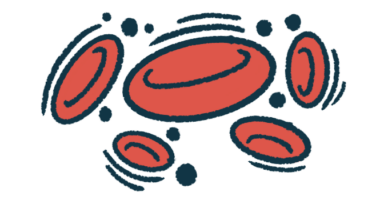Crovalimab, now PiaSky, wins FDA approval as treatment for PNH
Therapy OK'd for patients 13 and older to reduce red blood cell destruction

The U.S. Food and Drug Administration (FDA) has approved crovalimab — which works to reduce the destruction of red blood cells in paroxysmal nocturnal hemoglobinuria (PNH) — to treat teenagers and adults with PNH.
The therapy, which won formal approval from the FDA on June 20, is indicated to treat PNH patients ages 13 and older who weigh at least 40 kilograms, or 88 pounds. It will be sold by Genentech, a subsidiary of Roche, under the brand name PiaSky.
In PNH, blood cells lack certain proteins on their surface that normally protect them from being attacked by the body’s natural immune defenses. As a consequence, a part of the immune system called the complement cascade becomes abnormally activated, causing hemolysis, or the destruction of red blood cells, and ultimately driving PNH symptoms.
PiaSky works to block the activation of the complement cascade by targeting a complement protein called C5 and preventing it from being cleaved, or split, into two subunits, specifically C5a and C5b. Soliris (eculizumab) and Ultomiris (ravulizumab), two therapies previously FDA-approved to treat PNH, also work by targeting and preventing the cleavage of C5.
The newly approved treatment was developed with the aim of providing more convenience to patients than is had with those older therapies. After loading doses, Soliris is given by an infusion into the bloodstream every other week, while Ultomiris may be given by infusion every other month, or by weekly subcutaneous (under-the-skin) injection every week; the subcutaneous administration is for adults only.
With PiaSky, patients will receive the first dose via an intravenous infusion, then another four subcutaneous doses will be given once weekly. After those loading doses, maintenance doses are given by subcutaneous injection every four weeks, or about once per month. In patients who are switching to PiaSky from Ultomiris or Soliris, the first intravenous loading dose of PiaSky should be given no sooner than the time of the next scheduled dose of the previous therapy.
US approval of PiaSky for PNH follows similar decisions in China, Japan
According to its prescribing information, PiaSky’s administration — including the initial infusion and subsequent subcutaneous injections — should be carried out under the guidance of a healthcare professional.
Common side effects of PiaSky include infections, allergic reactions, and infusion- and injection-related reactions, such as pain, redness, and headache.
Like other C5-targeting therapies, PiaSky also carries a boxed warning noting that it can increase the risk of serious, potentially life-threatening meningococcal infections. Patients should be vaccinated against such infections before starting treatment. Due to the risk of meningococcal infections, PiaSky is only available in the U.S. through a restricted program, called PiaSky REMS, which ensures that only certified healthcare professionals can prescribe the medication.
The FDA’s approval of PiaSky was mainly supported by data from the Phase 3 COMMODORE 2 clinical trial (NCT04434092), which tested PiaSky against Soliris in 204 PNH patients.
Participants were randomly assigned to receive PiaSky or Soliris, at their recommended dosing regimens, for a period of 24 weeks, or about six months. After that, patients had the choice to either continue or switch to PiaSky during an extension period.
Both therapies were comparable in terms of their ability to prevent hemolysis and enable patients to remain free of blood transfusions, the results showed.
Specifically, data from COMMODORE 2 showed the mean proportion of patients achieving hemolysis control from study week 5 to 25 essentially was identical in those treated with PiaSky and Soliris (79.3% vs. 79%). The proportion of patients who remained transfusion-free from the study’s start to week 25 also was similar (65.7% vs. 68.1%).
PiaSky won its first approval for PNH in China earlier this year. The medication was also recently approved for PNH in Japan.








